The Glorious 50th Anniversary of Sri-Sri Radha-Londonisvara
By Jonathan Bearman, ISKCON-London Communications | Jan 03, 2020
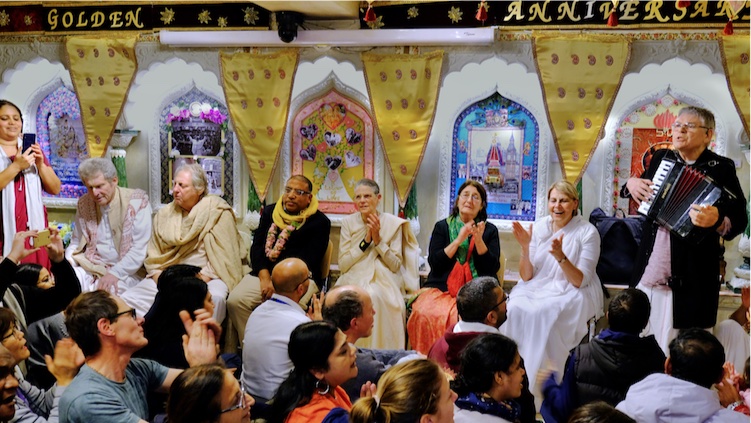
Nothing could more illustrate the blossoming of ISKCON in the heart of the UK than the recent 50th anniversary festival to mark the installation by Srila Prabhupada of the Radha-Krishna Deities known as Sri Sri Radha-Londonisvara in central London, the Deities who also have a historical significance in that They are the first large Radha-Krishna Deities in ISKCON.
A truly memorable event, London has never seen the Hare Krishna movement like this before. Running for nine days from Sunday 24th November to Monday 2nd December, the festival showcased exceptional displays of performance arts and visual arts, poetry readings and kirtans, maha harinamas and an open-top bus harinama, historical accounts of Radha-Londonisvara and offerings of wisdom from some of its founders half a century ago – and, throughout it all, a series of dazzling, themed darshans by Their Lordships Themselves, the Lords of London.
From the launch of the festival at the legendary Eventim Apollo in Hammersmith on Sunday 24th November, for what was described as the “Krishna Spectacular’, it was evident something special was going on. It was as if the 64 arts and crafts listed in the Brahma Samhita for Goloka Vrindavan had descended among us – arts and crafts learned by Sri Krishna himself from his preceptor, Sandipani, in Mathura, and therefore held precious by the Supreme Personality. In 1969, Srila Prabhupada told his early disciples that Sri Sri Radha-Londonisvara would bring us close to Vrindavan – and the anniversary festival was witness to this continuing manifestation.
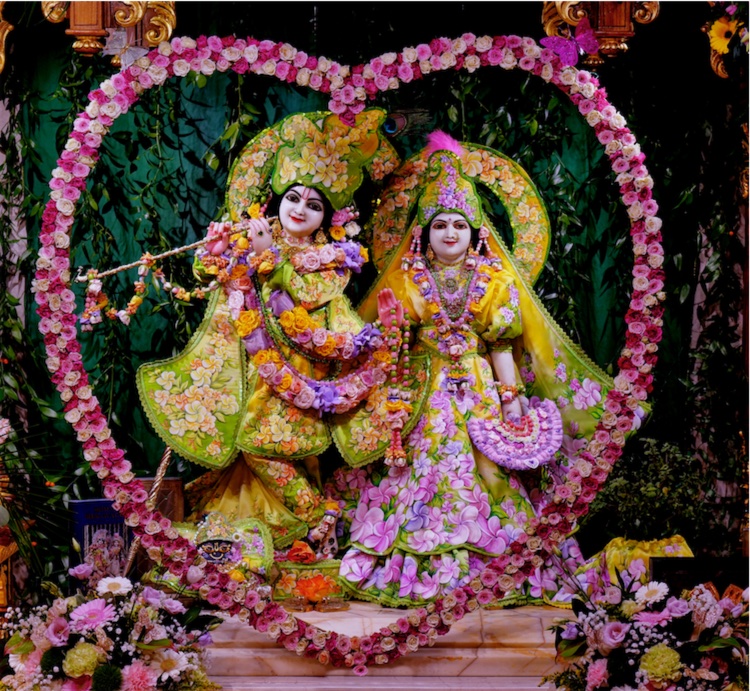
Sri Sri Radha Londonishvara
The Apollo stage allowed scale for the full-rein of the performance arts, while the 3000-seat auditorium gave the rare opportunity for substantial audience participation, most apparent with the rousing rendition of Londonisvara from Jayadev dasa and his mantra choir. Yet while Jayadev brought the audience to their feet in typical barn-storming style, Jahnavi Harrison in a more gentle way touched hearts with mellifluous, soul-penetrating tonality, and Bali Rico charmed with pulsating lyricism, this time free from the mrdangas of the Mayapuris. Fifty years after George Harrison produced Govinda with the first London disciples at Apple Studios in London’s Saint John’s Wood, relying on the unforgettable voice of Yamuna devi dasi, the Apollo show made it clear Krishna consciousness has lost none of its ability to move people by a powerful vocal offering.
The large stage also accommodated a significant dance repertoire that was undeveloped in early years of ISKCON. The Apollo event revealed how Krishna consciousness was finding expression in modern and contemporary dance with the display and tribute to Krishna by the Samadhi Dance Company and the impressive use of dance, including acrobatics, by the Natya Nectar Dance Company, to illustrate the journey of the jiva through the karmic entanglements and sensory delusions of the material world until the embodied soul finds refuge at the lotus feet of Krishna. Accounting for the largest section of the Apollo show, Natya Nectar’s performance left the audience gasping with its imaginative trapeze work, acrobatic use of a large wheel to portray the revolving captivity of the jiva in the world, and trance-like turning historically associated with sufism and the dervishes, but used by Natya Nectar in glorification of Krishna.
And yet slotted within these memorable performances were two quieter interludes. One saw the entry of three of the original founders of ISKCON in the UK – Shyamasundar dasa, Gurudas dasa and Malati devi dasi. All had travelled from the US to be pioneers in London at the request of Srila Prabhupada in 1968, and had now travelled back from the US as special guests of the 50th anniversary in London. With humility learned while serving Srila Prabhupada, they retold in simple terms how the Hare Krishna London story began and how they secured the presiding Deities of the London temple, named as Sri Sri Radha-Londonisvara by Srila Prabhupada, and from which so much has now followed, to the extent that the Hare Krishna presence they founded in London all those years ago has become five decades later a recognised perennial feature of London-life.

In another quiet interlude, Radhanath Swami, a senior member of ISKCON’s governing body, spoke about the necessary antidote to the delusions of the material world, the chanting of the name of Krishna. With a lifetime of devotion and 40 years of experience of spiritual traditions in India, he distilled his wisdom into a simple message for the audience, explaining why the Hare Krishna Maha Mantra is critical to all in this material world who will listen: that it brings about purification in the heart and, like the polishing of a mirror, allows the embodied soul to ever-more reflect God and find love for God.
Following the Apollo show, the festival moved its centre of gravity to the Radha-Krishna Temple off Oxford Street where the development of Krishna consciousness in London could be explored in more depth. There, for the next eight days, the festival progressed with daily themes, beginning with the founding of a temple in London. Entitled “A Labour of Love: How it All Began”, the theme on Monday 25th November (Day 2) was a focus on how the original pioneers worked selflessly in unfamiliar conditions to fulfil Srila Prabhupada’s desire for a temple with presiding Deities in London, and how in this undertaking they depended on the invaluable help of Beatles-member George Harrison. And the story of how those Deities arrived at the temple was, as part of this day’s theme, revisited by the first pioneers present at the time and now reunited: foremost among the memories were how Tamal Krishna Goswami and Shyamasundar dasa abetted Srila Prabhupada in taking-off with the gift of the Radha-Krishna Deities from the house of a hesitating Mr. Goyal in Stratford, East London; and how They were installed at the first temple in Bury Place, Bloomsbury; and how also, before that, Shyamasundar dasa carved the Deities of Lord Jagannatha, Lord Baladeva and Subhadra Devi on instructions from Srila Prabhupada from wood salvaged from a dockyard on the Thames. Over fifty years, it has all become the stuff of ISKCON legend.
It was therefore a blessing that Shyamasundar dasa, Gurudas dasa and Malati devi dasi were present for the 50th anniversary, and that other early followers of ISKCON made their way from around the world. Joining the three pioneers on the Monday to talk about their ‘Labour of Love’ were Radhanath Swami, a disciple of Srila Prabupada since 1973, and another early member of ISKCON in London, Ranchor dasa. Radhanath Swami spoke of the humble service spirit that had been learned from Srila Prabhupada, while Ranchor, who helped with the Radha-Krishna Temple building, told in poetic form of how his journey of service to Krishna began by taking refuge like many others at the feet of Radha-Krishna in London.
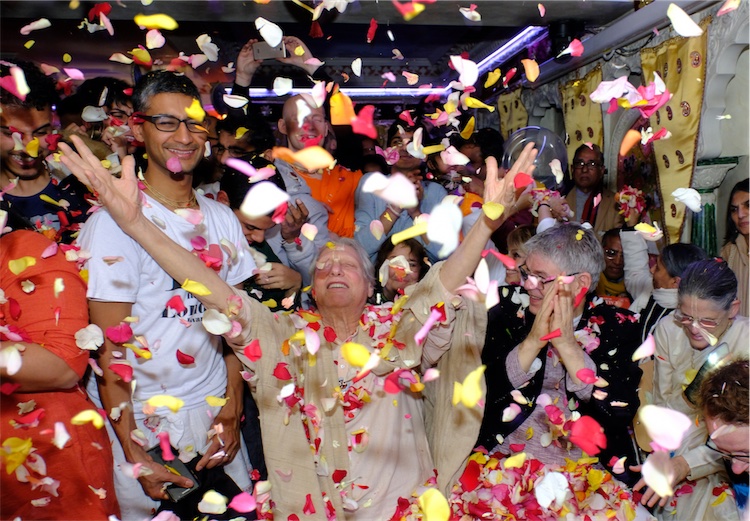
Thus:
Encircling the city of my days and nights,
Welcoming its lost souls to bask in Your golden gaze,
I sat through a night of mysteries at Your feet.
Poems in fact became a major offering to Sri Sri Radha-Londonisvara throughout the festival. Ahead of events, a collection of poems, prose and prayers had been gathered from devotees as an offering to Their Lordships and selective works from the resulting “Offerings of Love for Sri Sri Radha-Londonisvara: Poems and Prayers for Fifty Years” compilation were read out during the days of the festival. Prominent among them were works by the original and early members including Shyamsundar dasa, who looking back could declare:
Oh, Sri Sri Radha-Londonisvara, how beautiful You have become, more beautiful than anything possible, and how perfect Your reign from this Soho palace.
The first day of the festival at the Radha-Krishna Temple also saw devotees gather for a maha harinama, perhaps the largest ever in London. It was to be succeeded by maha harinamas on each day of the festival, with the maha harinama on Tuesday combined with a Rathayatra procession and then outings to notable London sights and public attractions, among them Leicester Square and Carnaby Street. Such is now the accepted presence of Hare Krishna in London that there was little hostile reaction; in fact, members of the public cheered and some joined in. Likewise, with the Saturday open-top bus harinama around the capital. If anything, the imaginative bus harinama, using the iconic red routemaster buses, with jubilant musicians and chanters aboard, will have further embedded the Hare Krishna phenomena in the London scene, while creating a carnival atmosphere in the depth of winter.
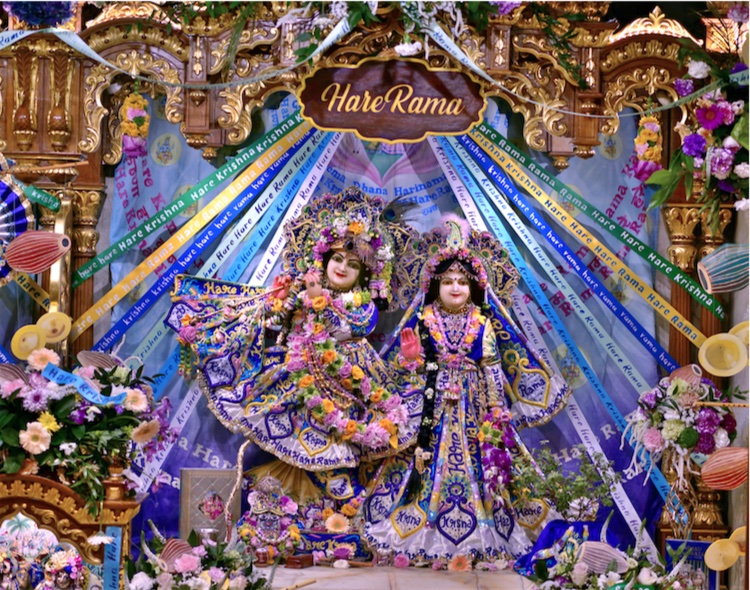
Day 3 of the festival was devoted to the advent of the London Rathayatra, the annual chariot procession of the Deities Lord Jagannatha, Lord Baladeva and Subhadra Devi from Hyde Park to Trafalgar Square, the central point of London. Although the first devotees began the yatra in the summer of 1969, it took them time to develop the knowhow to manually manoeuvre chariots with seven-foot wheels in the London streets. Eventually, though, the competence and construction skills were cultivated and in 1973 Srila Prabhupada blessed the wishes of the London devotees with his first attendance at the London Rathayatra. More than forty years on, it has now become a huge yearly event attracting large crowds and requiring the provision of prasadam on an unprecedented scale in Trafalgar Square.
The arrival in London of Srila Prabhupada set the theme for Day 4. When he landed at Heathrow on 11 September 1969, Srila Prabhupada was suddenly at the centre of publicity due to the favourable circumstances created by the release of the Hare Krishna Maha Mantra by his devotees on the Beatles’ Apple Records label that summer. Around 40 reporters awaited him after he stepped off the plane, wanting to get a sight of what was described by the news media as the Beatles’ Guru. At the time, the Beatles were a huge, unparalleled music phenomenon with a mass youth following. Prabhupada accepted this sudden celebrity status caused by association with Beatles because it helped establish Krishna consciousness; and if the Beatles took up the Maha Mantra it would introduce Krishna to millions of young people. For the same reason, he therefore accepted the hospitality of Beatles’ frontman John Lennon at Tittenhurst Park, although he was anxious to move to London to join his devotees who were building the Radha-Krishna Temple at Bury Place. As ever, he wanted to be close to the devotees who had committed their lives to serving Krishna – and to the site of the first Radha-Krishna Temple. Highlights of the day’s festival was a unique darshan on the altar of pictures of Srila Prabhupada in London, a London memories class of Srila Prabhupada by Dhananjaya dasa, one of Srila Prabhupada’s early disciples in the UK, and a magnificent offering of 50 (in fact, 57) cakes by the community, no one cake the same, on the Temple altar.
On Day 5 of the festival, attention turned to the ceremonial installation of the Deities of Radha and Krishna at the Bury Place Temple by Srila Prabhupada and this was followed the next day by the theme of ‘London is Vrindavan’. These themes were drawn from Srila Prabhupada’s revelation to his devotees that with the installation of the Deities those who came into Their presence and meditated and focused on Them would be enclosed within spiritual Vrindavan. Srila Prabhupada, by installing Radha-Krishna Deities, made London into a spiritual abode where Their Lordships would mercifully rule. He was well-aware that it would take time for the spiritual abode to manifest around Them, but with the installation he was sowing the seeds of something much bigger; in fact, to use a different metaphor, he had set in motion a kind of synergy between the Deities and a place called London, a mutually reinforcing bond that has grown to this day. Knowing this, Srila Prabhupada called Them Sri Sri Radha-Londonisvara, the Lords of London.

Throughout all the days of the festival at the Radha-Krishna Temple, it was the visual appearance of Sri Sri Radha-Londonisvara that was truly awesome, spell-binding. You simply ran out of superlatives to describe Them: They radiated, glistened, mesmerized, dazzled, looked stunning and glorious, just beautiful. They were of course Srila Prabhupada’s favourites and he maintained that They had appeared in London by Their own will as part of Their causeless mercy. To take darshan of Them these nine days was to be like Arjuna brought into the presence of the Lord’s grace (pusti), splendour (sri), fame (kirti), invincible potency (maya) and miraculous powers in his venture into the spiritual realm (as reported in the Srimad Bhagavatam, 10.89.57).
Each day, the Deities gave all those who visited the temple and of course the thousands who witnessed online, beautiful new themed darshans to match the themes of the festival and this allowed a precious opportunity for devotees to offer innovative, crafted service to Them. In fact, it was an occasion to apply more of the arts and crafts and qualities of Vrindavan, as listed in the Brahma Samhita and Srimad Bhagavatam, such as painting, flower arranging, carpentry and, indeed, the art of making delicious food as prasadam.
The darshans included the Deities appearing majestically on the red carpet on the day of Krishna Spectacular, being enclosed within a rose-filled heart, and enthroned as the King and Queen of London. Lord Jagannatha, Lord Baladeva and Subhadra Devi looked delightful on Their Rath cart on the Rathayatra-themed day. Darshans on two of the days were dedicated to honouring Srila Prabhupada’s time in London and celebrating the start of the 2019 Srila Prabhupada Book Marathon with a display of Srila Prabhupada’s books throughout the altar. On the penultimate day of the festival, the Holy Names were streaming from above Their Lordships. Finally, and most suitably, Their Lordships appeared perfectly against a painted panaroma of London, Their kingdom. And every day, They appeared sumptuously and exquisitely dressed.
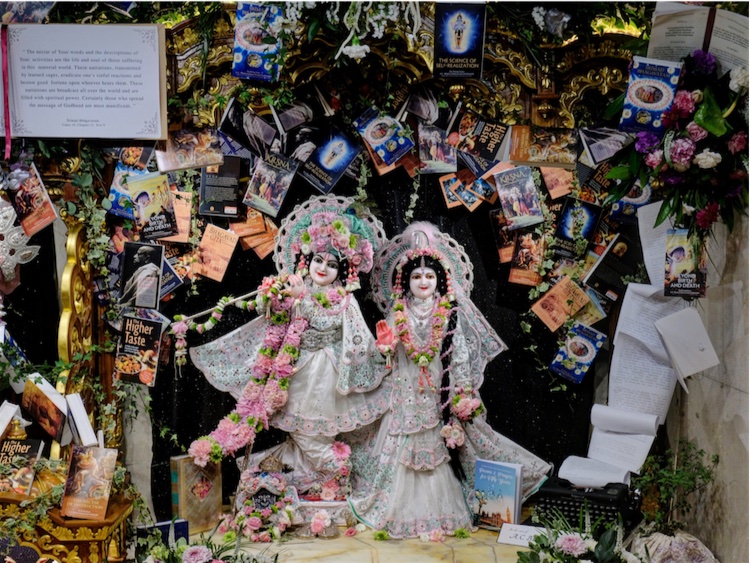
Golden Anniversary Week organizer, Devaki devi dasi, says “Certainly a major highlight for devotees during the Golden Anniversary Week was the beautiful darshans – nine days in a row, starting from the day of Krishna Spectacular, we had nine special darshans, all based on the theme of the day, to deepen our meditation on an aspect of ISKCON-London’s history.
My inspiration behind this was my spiritual master, HH Sivarama Swami, and the gorgeous and splendid festival darshans that take place in New Vraja Dhama in Hungary, under his inspiration and leadership. Every time you go there, you get excited by deity greetings and what the altar will look like, what the Deities will wear, etc. and then when the curtains open you are in complete joy.
I was determined that we “pull out all the stops” for the darshans during this most-wonderful 50th Anniversary for the pleasure of Sri Sri Radha-Londonisvara, Srila Prabhupada, the senior devotees who would be present, and of course, our community.
It was a challenge to organise and took months of planning and preparation as well as it being an intense marathon during the festival week making and putting up the decorations on the altar as well as taking down old ones each day, but everything was possible due to Their Lordships’ blessings, the empowerment and support given by our Temple President, Jai Nitai dasa, and Head Pujari, Murli Manohara dasa, the diverse and wonderful abilities and team spirit of the devotees who assisted, as well as our Golden Anniversary sponsors.
During these nine days, everyone was talking about the darshans and excited what the next day’s darshan would be like. It was quite wonderful to see how the darshans really captured devotees’ hearts and made them more connected to Their Lordships.
It was an experience of a lifetime, one that I will always treasure.”
From Day 7 of the festival, Saturday, to its conclusion on Monday 2nd December, the actual anniversary date of Sri Sri Radha-Londonisvara’s installation, the festival wound-up to an experiential climax. Day 7 was a celebration of the sankirtan mission undertaken in London by devotees in the early years and it related how they managed in the different conditions to keep faith in the sankirtan mission as inaugurated by Sri Caitanya Mahaprabhu in the late 15th and early 16th centuries in Bengal. Following on, Day 8 was devoted to the theme of chanting the Holy Names and the early success achieved by devotees through cooperation with the Beatles and George Harrison to establish awareness of Hare Krishna in the UK.
The apotheosis of the festival, its highpoint, came on Day 9 and was sublime. Towards the close, Jayadev dasa returned to a packed Temple Room to lead the singing of the temple anthem, Radha-Londonisvara, to be followed by the finalé of an unprecedented – for London – pushpa abhishek for the Deities, in which They were showered by two tonnes of rose petals that flooded the entire altar. Then when the Deities released the petals as blessings back to the devotees, the devotees joyously showered each other with handfuls of petals; and at the end, the temple was left two inches deep in petals, and roses were strewn in a trail down Oxford Street, London’s most material street. After the petals were cleared up from the Temple Room, many stayed on relishing the lovely kirtan and eagerly awaiting the final darshan of the Deities in a new night outfit.
Devaki devi dasi reflects “Thank you to all the senior devotees present who made the Golden Anniversary Week so special. We are so honoured to have had the association of some of the pioneers and Srila Prabhupada disciples present. The Temple Room was packed each day, morning, afternoon, and evening, with the community of ISKCON-London feeling very grateful and privileged to hear from such seniors on special remembrances and stories of our ISKCON-London history.”
At the end of all this, what is to be said? First of all, as well as the actual events, what was inspiring was the humble spirit of service involved and offered by large numbers of devotees working in cooperation; secondly, the festival has given us a milestone to judge the progress of the Hare Krishna movement in the UK. Perhaps less obvious than the firm evidence of attendance at the festival is the likelihood these events have a certain soft power and generate a wider hinterland that becomes fertile territory for the future. Fifty years on Krishna is no longer alien to the British and eyebrows are no longer raised at the subject in the political Establishment or armed forces. Of course, there is huge service lying ahead, but thanks to the early pioneers, the groundwork has been done, and for that, there must be enormous gratitude to Sri Sri Radha-Londonisvara, the Lords of London.
* * *
Watch the classes: http://bit.ly/goldenanniversaryweek-playlist
Watch a special film, produced by Bhaktavatara dasa, celebrating 50 years of the Hare Krishna’s in London, which was also shown as part of the celebrations: http://bit.ly/50yearsofservice















